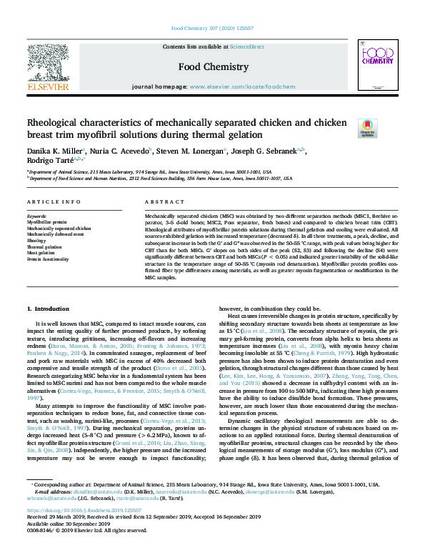
Article
Compositional differences among types of mechanically separated chicken and their Influence on physicochemical attributes of frankfurter-type sausages
Meat and Muscle Biology
(2021)
Abstract
Mechanically separated chicken (MSC) from 2 different separation methods (MSC1, Beehive separator, aged bones [Provisur Technologies, Mokena, IL]; MSC2, Poss separator, fresh bones [Poss Design Limited, Oakville, Ontario, Canada]) and chicken breast trim (CBT) were used as raw materials in frankfurters. Texture, color, and lipid oxidation were measured over a refrigerated storage period of 98 d. Both MSC were higher in fat and lower in moisture than CBT. MSC frankfurters had lower L* and higher a* values than CBT frankfurters, with MSC2 frankfurters having the lowest L* and highest a* (P < 0.05). Thiobarbituric acid-reactive substances values were higher in MSC1 frankfurters (P < 0.05) than in CBT and MSC2 frankfurters. Texture Profile Analysis hardness, cohesiveness, resilience, and chewiness were highest in MSC2 frankfurters. Differences among MSC resulted in detectable differences in finished product attributes, with MSC2 frankfurters being darker and redder and having lower levels of lipid oxidation than MSC1 frankfurters, underscoring the importance of understanding the specific functional attributes of MSC obtained by different processes prior to product formulation and manufacturing.
Keywords
- mechanically separated chicken,
- mechanically separated poultry,
- frankfurters,
- sausage
Disciplines
Publication Date
August 3, 2021
DOI
doi:10.22175/mmb.12294
Citation Information
Danika K. Miller, Laura E. Yoder, Steven M. Lonergan, Joseph G. Sebranek, et al.. "Compositional differences among types of mechanically separated chicken and their Influence on physicochemical attributes of frankfurter-type sausages" Meat and Muscle Biology Vol. 5(1) Iss. 33 (2021) p. 1 - 10 Available at: http://works.bepress.com/rodrigo_tarte/54/
Creative Commons license

This work is licensed under a Creative Commons CC_BY International License.
